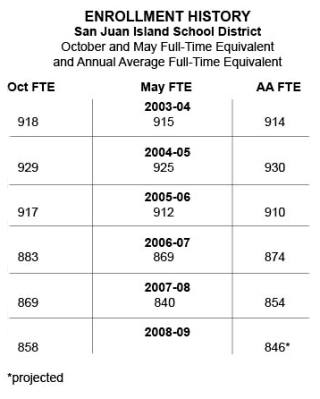Turns out, there are only 10 fewer students attending San Juan Island public schools right now, compared to the same time in 2007.
There are 858 full-time-equivalent students (a kindergartner counts as .5 FTE, and some home school and private school students take only a class at a public school), according to the school district. In October 2007, there were 868 FTEs, according to the school district.
An earlier version of this story compared the current FTE to last year’s head count, which is higher because the head count includes part-time students and kindergartners. The district receives per-student funding from the state — currently $5,411.70 per student — based on its annual average FTE enrollment.
The current enrollment includes Stuart Island School, which was temporarily closed last year due to lack of enrollment.
The annual average enrollment for this school year is projected to be 840, 10 over the number projected in spring when the district forecast a $600,000 budget shortfall because of lower enrollment and a shortfall in the state Legislature’s financial appropriation for voter-mandated cost-of-living increases for teachers.
Thanks to private donors, the San Juan Public Schools Foundation and the San Juan Island Community Foundation, $550,000 was raised for educational services. The school district’s annual budget is about $7 million.
Superintendent Michael Soltman said housing costs are partly to blame for the declining enrollment.
“We are in a pattern of decline,” Soltman said. “We anticipate enrollment to drop to 750 to 775 students within the next few years.”
The drop of 28 students partly triggered the district’s financial instability; an average of 14 students leave in a typical year.
The San Juan Island School District joined more than 50 organizations and school districts in suing the state for full basic education funding. Statewide, there is currently a $2 billion gap between state K-12 funding levels and estimates of the cost of delivering required state-mandated programs. An approximate $2.65 billion gap in K-12 spending is estimated for 2009-10. Those figures were reported by the Northwest Education Service District 189.
In 1993, Washington ranked 11th in its adjusted per-student expenditure. In 2005, the state ranked 44th with a per-student expenditure of $7,432.
The search for a stable system of funding is dependent upon the state. With a pattern of declining enrollment, the district anticipates financial woes for the years ahead.
“We will be experiencing a substantial amount of program reduction in 2009-10 school year unless there is additional funding appropriated by the state or a substantial amount of fund raising,” Soltman said. “However, in this economic climate, it is unlikely we will be able to sustain the fund-raising we had last year.”
School Board President Boyd Pratt was amazed by the amount of community support given to the school district this year. “It was out of the ordinary. (But) we cannot depend on this level of donations every year. The state needs to provide adequate funding for schools. We should depend on our local levies only for supplemental income.”
A community forum is being scheduled in November to discuss ideas for reductions in expenses. Soltman believes cuts will be substantial in programs and staffing. Eighty percent of the school district budget is dedicated for staffing. He is currently working with principals and community representatives involving fund-raising efforts to organize projects needed for next year and long term.
Pratt anticipates some fund-raising to take place later this year, but not to the level of donations that occurred this past spring. He foresees dependence upon philantrophic and private donations to fund certain designated programs.
A financial task force and legislative advocacy efforts are under way to develop a five year financial projection plan for the district. High school PTA president, Deborah Nolan, is coordinating efforts to fully fund education by means of legislative advocacy.




